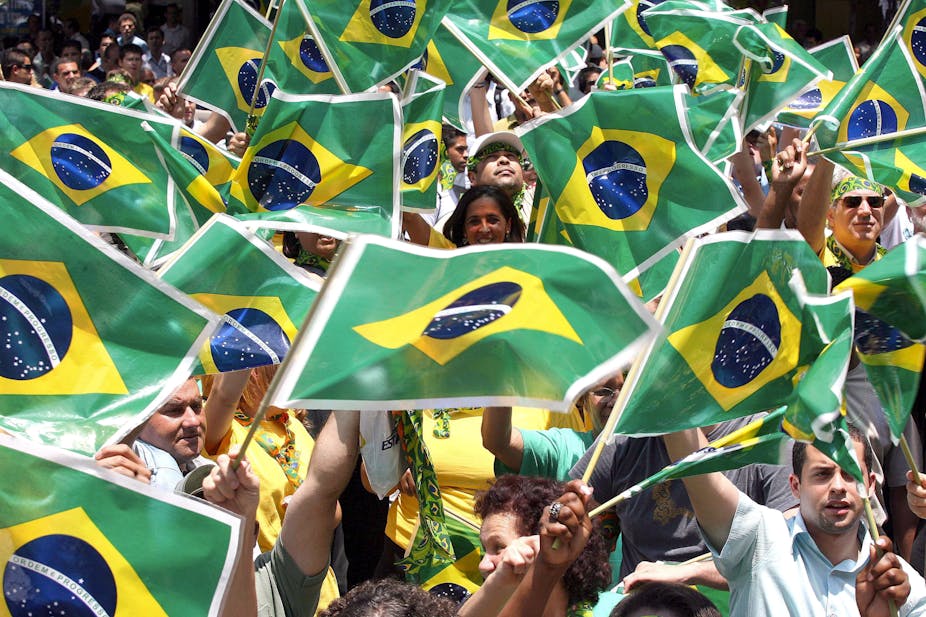It was a fearsome blow. It was the first World Cup after World War II, on home soil, and the country was desperate for international recognition. Brazil reached the final, only to lose 2-1 in a shock defeat to Uruguay. The match has forever been known as the Maracanazo – it was a national tragedy.
Now, 64 years later, Brazil is hosting the World Cup once more and the country has developed at a remarkable pace. With the eyes of the world on it once more, expectations are vast. The tragic collapse of the bridge in Belo Horizonte shows just how quickly views of a host country can change. But it’s worth looking back at Brazil’s economic development and the significant strides it has taken.
Growing economy
Since 1950, Brazil has grown to become the seventh largest economy in the world, ahead of Italy and just behind the UK. Per capita GDP in Brazil is just above US$11,000 per year, almost twice that of China, and seven times more than in India.
Brazilians have higher life satisfaction than would be predicted for this level of income. Much lower life satisfaction occurs in South Africa, Iran and Azerbaijan where income per person is the same. And, compared to the UK and USA, where GDP is 3.5 and 4.5 times greater, life satisfaction is about the same. All that extra wealth has not made us happier.
Green and gold
Brazil is also greener. In 1950, the football team played in white shirts and these were tossed away in embarrassment. They took up gold and green colours. In countries earning US$11,000 per person, carbon dioxide emissions to the atmosphere are predicted to be 4.4 tonnes per person. Yet in Brazil emissions are only 2.2 tonnes per person.
By comparison, the UK is far more carbon intensive, producing almost four times the carbon per person. China emits three times more per capita than Brazil, the USA and Australia about eight times. The proportion of energy generation in Brazil that is renewable is a remarkable 46%, due both to extensive hydropower and immense use of biofuels in vehicles.
Atmospheric carbon concentrations now exceed 400 parts per million: a safe operating space for humanity would be to revert back to 350 ppm. But this needs emissions to fall to 1.1 tonnes per person. Even the relatively green are not green enough. And, despite its relatively green economy, Brazil remains highly reliant on exporting primary commodities.
Money well spent?
All countries make policy decisions on where to spend their resources. Both Angola and Equatorial Guinea are oil rich, with rapidly growing per capita GDP, yet they have appalling under-five mortality rates of over 100 per 1000 births. Brazil has invested in health care and has reduced under-five mortality to 14, about the same as China. In Europe and North America, these are now at about 4-5, though the USA is the highest of the affluent countries at 7. India is the fastest-growing of the BRIC countries, yet its under-five mortality is a worrying 56 per 1000 births.
Brazil has much land, huge primary resources of minerals, forests and agriculture, yet vast cities. It is in both rural and urban contexts that the pressures of progress are growing. The Amazon rainforest is a vital global resource, both as a store of biodiversity and as a source of oxygen and sink for carbon. It is also important locally, home to indigenous people but is an easily combusted forest.
Land clearance, often for soya plantations, was running at more than 20,000 square kilometres per year until the world economic slowdown: now it is less than 7000 sq km. But Brazil still sells its family silver to fuel an economic boom based largely on exports of iron and steel, grain and meat, oil, machinery and hides. Its greatest buyer, China, is increasing its economic output by adding value to primary products.
Problems to address
The other pressure is in the cities, and here Brazil has problems. Safety is very poor, the worst in the OECD Life Index and there are 50,000 homicides per year or 137 each day. The gap between the wealthy and the poor is persistently wide, as in all BRIC countries, with Brazil’s income Gini coefficient (a measure of income distribution inequality) at over 50 – high for even the developing world. Educational inequality is also poor in Brazil and cuts a racial divide.
It is these social inequalities that fuel the continuing protests against the World Cup. If left unaddressed, they will threaten Brazil’s relatively greener and healthier economy.
A successful World Cup has the power to bring great joy to Brazil and, though it’s not been perfect, Brazil has come along way since 1950 in showing the world that they can host a global tournament. Social gaps will remain whatever the outcome, however, and natural capital will continue to be depleted unless new approaches are taken.
These are problems are not unique to Brazil – they are becoming universal. Indeed, in light of its development to date, Brazil could be better placed than many to find progress towards greener and healthier economies that persist and work for all the population.

